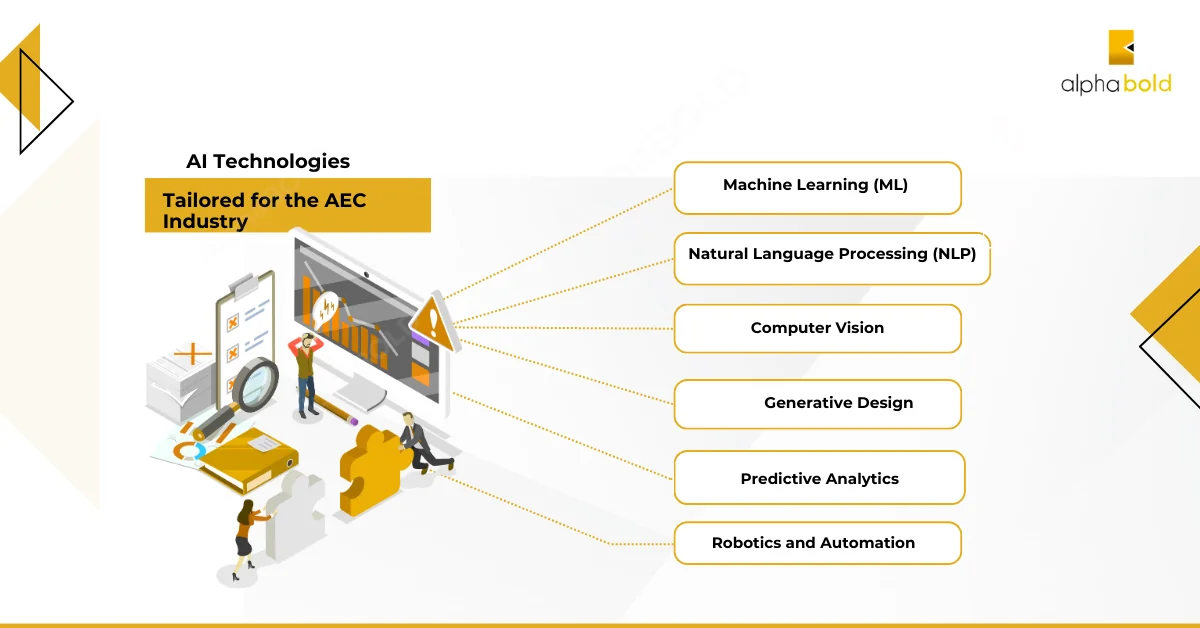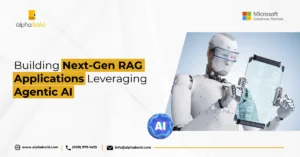Table of Contents
Introduction
The Architecture, Engineering, and Construction (AEC) industry embraces technological advancements, evolving from hand-drawn blueprints to CAD and BIM. Today, AI drives significant transformations by revolutionizing design, construction workflows, and project management. With machine learning, predictive analytics, and automation, AI enhances efficiency, optimizes designs, mitigates risks, and improves on-site safety.
This blog discusses how AI is transforming the AEC industry and highlights the importance of adopting AEC AI tools for improving operations and project outcomes.
AI Use Cases in AEC
Artificial intelligence (AI) advances in the architecture, engineering, and construction (AEC) industry enhance design, construction, and project management. Predictive modeling and automation improve efficiency, reduce costs, and enhance decision-making. Below are key use cases transforming the sector:
1. AI and Digital Twins:
2. AI for Smart Cities and Urban Planning:
3. AI in Modular and Prefabricated Construction:
4. AI-Enhanced Smart Contracts & Blockchain:
5. AI in Workforce Management:
6. AI in Construction Robotics:
The construction site is central to any AEC project, showcasing the interaction of workforce, machinery, and materials. With advancing technology, AI is transforming operations, with intelligent machines like robots and drones becoming key collaborators in construction.
- Robotic Automation: AI-powered robots improve construction tasks like bricklaying, welding, and concrete dispensing through precision and collaboration with human workers. Robotic arms with computer vision can sort and place materials based on real-time site conditions, enhancing efficiency and accuracy.
- Drones with a Vision: AI-equipped drones autonomously capture high-resolution images and videos for real-time monitoring and automated site inspections. They detect structural anomalies, track progress, and offer insights to optimize construction workflows.
- Material Handling and Logistics: AI-driven vehicles streamline the movement of heavy materials, optimizing routes based on site conditions and traffic. AI reduces manual handling risks while accelerating construction logistics and material management.
Let's Discuss Your Use Case:
Further Reading: Robotic Process Automation
Looking to transform your construction management experience with AI?
Collaborate with AlphaBOLD and acquire ideal AEC AI Solutions customized for your business.
Request a ConsultationNew Industry Trends & Advancements of AI in the AEC Industry

AI-Powered BIM:
Generative Design:
Performance Analysis:
Sustainability:
AI-Powered CAD:
Virtual Reality (VR) and Augmented Reality (AR):
When combined with artificial intelligence, VR and AR enable interactive design visualizations in the architecture, engineering, and construction industries. Clients and architects can experience real-time virtual walkthroughs and make instant design adjustments based on AI-driven insights.
Accident Prediction:
Real-time Monitoring:
Further Reading: AI-Driven Predictive Analytics Via Power BI Insights
AI Adoption Barriers
Despite the transformative potential of AI in the AEC industry, several challenges hinder widespread adoption. High implementation costs, workforce reluctance, and regulatory complexities are key obstacles that firms must navigate.
- Cost: Implementing AI in the AEC requires significant investment in technology, infrastructure, and skilled personnel, making adoption challenging for many firms.
- Workforce Resistance: Employees may resist automation in the AEC sector due to concerns about job security and the learning curve associated with new AI-driven workflows.
- Regulations: Compliance with evolving industry regulations and standards can slow AI adoption, as firms must ensure that AEC AI solutions meet legal and safety requirements.
Ethical Concerns of AEC AI Tools
As AI becomes more integrated into AEC workflows, ethical challenges around accountability, job displacement, and data privacy emerge. Companies must address these concerns to build trust and ensure responsible AI implementation.
- Accountability & Liability: AI-driven decisions in design and construction raise concerns about responsibility for errors, defects, or project failures.
- Job Displacement: Increased use of AEC AI tools and automation may reduce demand for certain labor-intensive roles, impacting employment in the sector.
- Data Privacy & AI Surveillance: AI-powered monitoring tools, including machine learning for the AEC industry, raise concerns over worker privacy, data security, and ethical surveillance practices.
Supercharge Your Construction Operations with AI
Contact us today and experience the transformative power of AI in the AEC industry.
Request a ConsultationThe Financial Aspect: ROI & Cost Implications
In any strategic business decision, especially adopting new technologies, the financial implications invariably come to the fore. While the potential benefits of AI in the AEC industry are manifold, it’s essential to weigh these against the investment required. Let’s dissect the financial aspect of AI integration into the AEC sector.
Cost-Benefit Analysis of AI Integration in AEC:
Navigating the economic landscape of AI integration requires a clear understanding of both the initial expenditures and the potential long-term savings and revenue opportunities.
- Initial Investment: Undeniably, the adoption of AI technologies requires an upfront investment. This includes not just the cost of the technology itself but also training, infrastructure upgrades, and potential integration challenges.
- Operational Savings: With AI’s efficiency and precision, projects can see significant reductions in delays, reworks, and waste. Automated machinery, optimized logistics, and predictive maintenance can lead to tangible savings in manpower and materials.
- Improved Safety: Predictive analytics and real-time monitoring reduce accidents, translating into fewer compensation claims, reduced insurance premiums, and a stronger reputation in the industry.
- Enhanced Project Outcomes: With AI-driven design optimization and site operations, the quality of the final structures is often superior, leading to higher client satisfaction and potentially more lucrative future contracts.
- Long-term Growth: AI integration can position a firm as a frontrunner in technological innovation, attracting clients and top talent in the field. While the initial costs might be substantial, the long-term ROI, both tangible and intangible, can justify the investment.
Solutions Tailored for Different Scales of AEC Firms:
- For Large Firms: Major players in the AEC industry might have the financial bandwidth to invest in comprehensive AI solutions. This includes cutting-edge machinery, enterprise-level AI software integrations, and dedicated teams for training and deployment. Their scale allows them to amortize the costs over multiple projects, reaping benefits on a grand scale.
- For Mid-sized Firms: While they might not have the resources of industry giants, mid-sized firms can still integrate AI strategically. Instead of a broad adoption, they can focus on specific pain points, such as AI-driven design tools, drones for site inspections, or predictive analytics for project management.
- For Small Firms: Startups and small-scale firms might feel the financial pinch the most. However, the rise of AI has also seen the emergence of cloud-based, pay-as-you-go solutions. These firms can access AI tools on-demand, without heavy investments in infrastructure. Partnering with tech providers or entering collaborative industry consortiums can also offer avenues to harness AI’s benefits without breaking the bank.
Conclusion
The Architecture, Engineering, and Construction (AEC) industry is on the verge of significant transformation driven by the integration of Artificial Intelligence. AI offers essential solutions to existing challenges and opens new opportunities, impacting everything from design and planning to construction site operations.
The key to progress lies in our readiness to adapt and innovate. This shift encourages AEC professionals—architects, engineers, and constructors—to embrace AI and help shape its future within the industry. AlphaBOLD enables you to make the most out of AI in the AEC.
Explore Recent Blog Posts









